#amphibious mammal
Explore tagged Tumblr posts
Text
Wet Beast Wednesday: platypus
Since I've been designing original Pokemon for a hypothetical Australia-based region I've been doing some research on Australian fauna and one of them (which I made into a starter) is the famous platypus. Join me and we will learn why these animals are so weird I don't blame the European naturalists who thought they were hoaxes until presented with a live specimen. I mean you can blame European scientists of the time for a lot of things, but doubting the platypus isn't one of them.
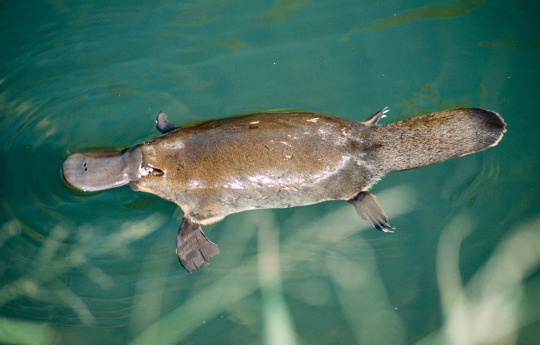
(image: a platypus at the surface of the water, seen from above. It is a brown, furry mammal. Its legs are very short, with long webbed tows. Its tail is broad, flat, and furry. It has a large duck-like bill at the front)
The first preserved Platypus specimens brought to Europe were thought to be hoaxes made by taxidermists attaching parts of different animals together, like the Fiji mermaid or jackalopes. Its pretty clear why they thought this as platypi (there's not definitive plural of platypus and platypi is the one I refer) look like real-life chimeras. A mole-like body (indeed, they were originally thought by naturalists to be species of mole) with a duck's bill, otter's feet, and beaver's tail. In fact, platypi are none of the above but are instead one of five surviving species of monotremes, the smallest and most basal lineage of extant mammals alongside the marsupials and placentals. Monotremes possess many traits distinct from other mammals and taxonomists currently believe that the monotreme lineage split off from the lineage of live-birth giving mammals prior to marsupials and placentals diverging from each other. Differences that monotremes have from all other mammals include a lower body temperature, lack of external ears, different jaw and inner ear structures, a cloaca (combination of the excretory and reproductive tracts into a single hole), more reptile-like embryo development, and the fact that they lay eggs instead of giving live birth. Many of these traits (especially the cloaca and laying eggs) are believed to be holdovers from pre-mammalian ancestors and thus monotremes are highly valued by scientists studying mammal evolution.
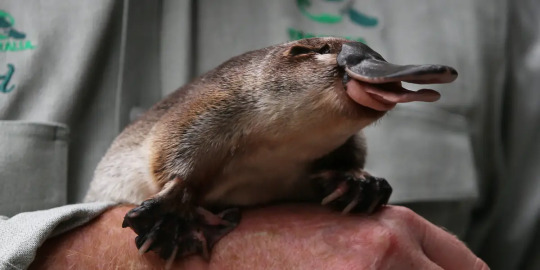
(image: a platyus standing on a person's hand. It is around the same size as the hand. It is seen from the front, with its head turned to the right. Its mouth is slightly open)
Platypi are semi-aquatic animals found in rivers and streams along eastern Australia and Tasmania. They are the only living members of their genus and family, though fossil relatives have been found. Their size varies based on habitat and ranges from 0.7 to 2.4 kg (1.6 to 5.3 lbs). Males average 50 cm (20 in) and females average 43 cm (17 in). Platypi are covered in fur that traps a layer of air to insulate them while swimming. The fur is bioflourescent, producing a blue-green glow when exposed to ultraviolet light. The tail is used to store fat and will glow larger in a well-fed individual. All four feet are webbed, the front feet more so. The style of swimming used by platypi is unlike that of any other amphibious or aquatic mammal. Other mammals use their hind feet and/or tails for propulsion. Platypi instead use their front feed for propulsion. The hind feet and tail are only used for steering. When on land, platypi curl up their front toes and walk on their knuckles to protect the webbing between their toes. The eyes are small and weak and are not used when hunting.

(image: a platypus seen from above and below, fluorescing under black light. Its top looks dark blue with splotches of purple while the underside is a lighter green-blue with purple towards the middle)
The bill is the most important organ for finding prey. All living monotremes are capable of electroreception, the detection of electric fields. These fields are produced when prey contracts its muscles and the platypus is sensitive enough to detect very small prey. The electroreceptor organs are located on the bill and run in lines from front to back. The distribution of the organs in distinct lines allows the platypus to determine the direction of the source of an electric field by sensing which line feels the field most strongly. The bill is also covered uniformly in mechanoreceptors used for touch. Platypi hunt by digging their bills through the sediment at the bottom of the water and detecting prey. This method of hunting and use of electroreception allows platypi to hunt in very murky water. Prey consists primarily of worms, insect larvae, and crustaceans. Platypi are born with teeth in their bills, but they fall out quickly and are not replaced. Some fossil species apparently retained their teeth into adulthood. The insides of the bill are lined with ceratodontes, plates covered in rough, keratinized surfaces that are used to grind up food.

(image: a platypus foraging for food at the bottom of a river. The front of its bill is poking into the sandy river bottom. There is a submerged log in the background and multiple small fish in the foreground)

(image: a scientific diagram showing three drawings of a platypus from three angles and the area it can detect electric fields. source)
As if all that wasn't strange enough, platypi are also one of the few species of venomous mammals. The male platypus has spurs on the hind feet that inject venom. This venom is powerful enough to kill dogs, but is not fatal to humans. Instead, it causes swelling and increases sensitivity to pain. This can last for weeks to months and can be agonizing. Female platypi are born with the spurs, but they never develop venom and fall off by their first birthday. Males use their spurs to fight over territory and mates.

(image: a person showing off a male platypus's spur. The platypus is mostly out of frame, but a hind leg and some fur is visible, wrapped in a sheet. A human hand is gripping the hind leg near the toes and holding it in place. The spur is curved and conical and larger than any of the actual claws. It is located near the heel)
Platypi live in simple burrows dug along the water's edge around 30 cm above the surface of the water. They are often hidden behind roots or plants. Platypi spend most of their time in the burrow sleeping for up to 14 hours a day. When not sleeping, they spend most of theer time in the water hunting. Dives last up to 30 seconds with a 10-20 second surface interval. Platypi will travel up to 7 km (4.3 miles) from their burrows to hunt. They maintain territories and will attempt to chase competitors of the same sex out. Males have larger territories than females and their territories usually overlap with those of 3 or 4 females. Platypi are nocturnal and crepuscular (active at dawn and dusk) but have been known to come out on cloudy days. They are typically active for 12 hours per day and spend most of that time hunting. A platypus eats up to 20% of its body weight daily. Platypi are preyed upon by snakes, goannas (monitor lizards), various birds of prey, and possibly crocodiles and invasive foxes.
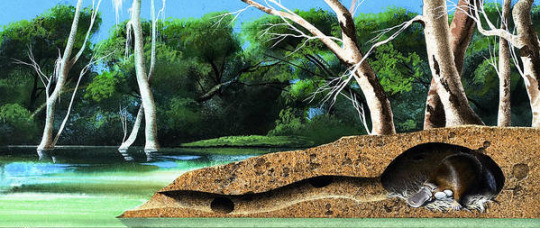
(image: a drawing of a cross-section of a platypus burrow. The burrow is located in a river bank with the opening right by the water. A long tunnel leads to a round chamber. In the chamber is a platypus with two eggs. Art by David Nockels)
Platypus mating season lasts between June and October every year. During this time, males will compete with each other for mates using their venomous spurs. Some males will maintain territories and force other males out while other males are more transitory and will go looking for mates. Females only mate with a single male every season. Strangely, females have two ovaries but only the left one is functional. After mating, the female will retreat to her burrow. While most egg-laying animals will lay they eggs as soon s they are formed, platypi retain their eggs internally for 28 days before laying them, after which they will continue to develop for 10 days before hatching. Most layings result in 2 eggs. The female curls around her eggs to incubate and protect them. Newborn platypi are called puggles and they are blind, hairless, and defenseless. As with other mammals, they feed on their mother's milk. Platypi do not have nipples and instead, the milk is secreted through the skin and into grooves on the mother's belly, where the puggles lap it up. While the puggles are developing, the mother spends less time out foraging, though she will increase the time foraging as her offspring develop. Weaning happes at 3-4 months, after which the juveniles will leave the burrow and set out on their own. Mothers have been observed laving behind soil plugs at the entrance to their burrows while there are offspring are in them. They are used to squeeze off water as the female returns to her burrow, preventing cold water from reaching the offspring.
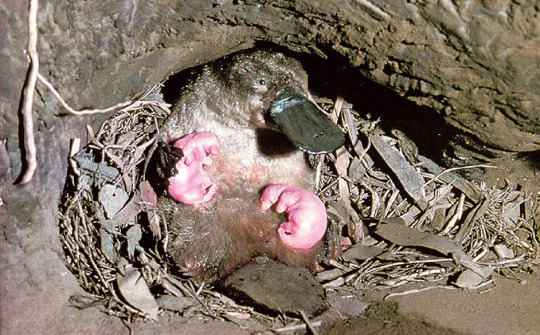
(image: a reconstruction of a mother platypus and puggles. They are in a dirt burrow lined with bits of leaves and bark. The mother is on its back and looking toward the camera. There are three puggles, which share the same body plan, but are very small and entirely pink. Tey are sitting on the mother's abdomen)
Platybi are classified as near threatened by the IUCN, though some argeu they should be reclassified as endangered. Their habitat range has decreased since European colonization of Australia and they are threatened by habitat loss, dams, pollution, and bycatch. Aboriginal Australians historically hunted them for food and Europeans also hunted them for fur, which was outlawed in 1912. The platypus was and is culturally relevant to Aboriginal peoples sharing its range, particularly the native peoples of the Murray river. There are multiple Dreamtime stories of the platypus, many dedicated to explaining how it ended up the way it is. In one, originating from the upper Darling river, a female duck named Daroo or was either seduced or kidnapped by a male water rat named Biggoon or Bilargun. After escaping, she laid two eggs that hatched into the first platypi, inheriting their mother's bill and webbed feet and father's body and fur. Another story from the same region says that the land animals, water animals, and birds all wanted the platypus to join their group and tried to convince it to join. The platypus decided that it didn't need to join any of the groups to be special, but still wanted to be friends with all of them and so took on traits from all groups.

(image: the Ironbarks Platypus, an Aboriginal Australian rock carving of a figure typically interpreted as a platypus. It is very simple, with a roughly rectangular shape with one rounded end. From one end is a simple loop usually interpreted as the platypus's bill. Four stick-like linbs emerge from the sides)
#wet beast wednesday#platypus#freshwater ecology#freshwater biology#biology#zoology#ecology#aquatic mammal#venomous mammal#amphibious mammal#monotreme#australia#animal facts
86 notes
·
View notes
Text

heard it's open season on yachts down here
#haven#taran#oc#dragon#painting#traditional media#underwater#idk im just throwing tags at the wall at this point#i love painting water#boats#sharks#haven acts like sharks are dogs. he feeds them his table scraps and finds it very annoying when they try to eat off his meals#but he finds it endearing#taran thinks it's annoying that sharks will hang around him. he prefers mammals#but he also swallows his food whole a good half the time so it's not really equivalent. haven tosses his bones aside#should i tag the species of snake taran is meant to look like... i think that would be a little crass but i see it a lot w people's fursona#b/c i subscribe to the black-backed jackal tag#ok fine why not#sunbeam snake#tiktok tts voice: surgically modifying my non-amphibious pet boyfriend so he can hang out underwater and kill boaters with me !#anyway this was another palette test bc i forgot to put any green on jazz the other day#EDIT. NO ONE MENTIONED THE TYPO 😭😭😭😭#favorite
68 notes
·
View notes
Photo
This bad boy can fit so many chromosones in it! *slaps platypus and is scratched by his venomous barbs*
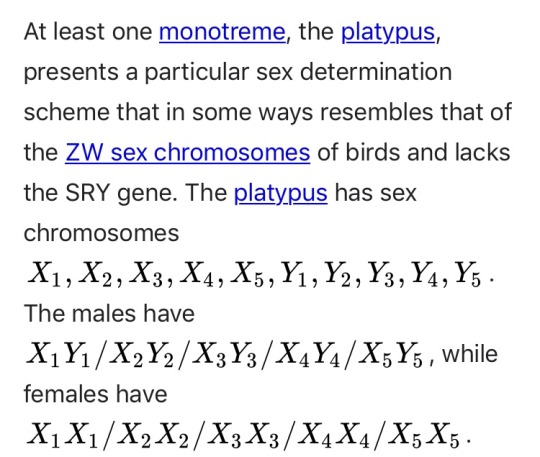
What the fuck
#nature#platypus#animal facts#I LOVE how weird these little creatures are#they've got 52 chromosones#they're amphibious mammals that lay eggs and feed their young milk#they hunt with electrolocation#their eyes have double cones and are more similar to hagfish and lamprey eyes than most mammal eyes#they're bioflurescent under black light#they're SHOCKINGLY good at climbing#they use their tails to carry nesting materials#just absolutely superb funky little critters
1K notes
·
View notes
Text

Hippopotame commun - Ses déjections modifient la composition chimique des eaux où il vit et favorisent la prolifération des poissons par les nutriments qu'elles contiennent.
Lieu : Zoo de Maubeuge.
#photo#photo animalière#animals photography#animaux#animals#wild animals#animaux sauvages#hippo#hippopotame#common hippo#hippopotame commun#hippopotame amphibie#mammifère#mammal
0 notes
Text


Kinda went crazy on dragon teeth anatomy! Biology geeking out under the cut
Bogsneak dragons are very crocodilian in appearance, and the fact that they prefer swampy environments definitely lends to this. Out of all the crocodilians, I’d say they resemble alligators the most due to the thicker, rounded snout, and the way the upper teeth poke out from their jaws; Crocodiles visually show both upper and lower teeth when the mouth is closed, while alligators only show upper teeth. Their teeth structure is like alligators; they’d possess around 74-80 sturdy, razor-sharp teeth specialized for vice-gripping their prey. Unlike alligators, Bogsneaks possess a forked tongue. It reminds me very much of a Komodo dragon's tongue, and I imagine they would use it to taste air as well. Bogsneaks eat meat and plants. Alligators are carnivores, but they have also been reported to eat various fruits as well!
Coatls are easy in one sense; they’re obviously snake dragons, but the question is… what snake? I’d argue that they’re visually similar to cobras, with the feather crest resembling a cobra hood, the head being vaguely cobra-shaped, and the fangs poking out of their mouth (cobras have permanently erect fangs). There’s two big differences here though; for one, Coatls are not said to possess venom. For another, Coatls only eat seafood, while cobras eat terrestrial and semi-aquatic prey. However, there are several snakes in the Elapidae family (cobra family) that eat seafood… sea snakes! In fact, there is one type of sea snake that is nonvenomous, but it only eats fish eggs; Coatls would have a diet more similar to other sea snakes, which eat fish, eels, marine gastropods, and other marine invertebrates. Coatl dentition would be a mix of cobras and sea snakes; they’d have the big fangs in the front with several smaller teeth behind the fangs on the upper jaw.
Fae dragons are insectivorous, and I think they’re most similar to geckos in terms of diet and dentition, as geckos are also insectivores. Faes would have rows of small, sharp, conical teeth on both the upper and lower jaws. I specifically researched geckos for Fae dragons, but if you wanted to go the more mammalian route, I’d say shrews are the best fit.
Fathom dragons are an interesting case. They have external ears like a pinniped, echolocate underwater like cetaceans, have amphibious gills, and travel in pods. I’d say they’re dentition is a mix of sea lions and orcas. They’d have the big canines that sea lions have, but the rest of their teeth would be more similar to orcas; interlocking and conical. However, Fathom dragons are omnivorous and eat plants and seafood; sea lions and orcas are both purely carnivorous and have not been seen eating plant matter of any kind. The plant part of their diet I think would be similar to manatees, which graze on seagrasses and other aquatic plants.
Like Bogsneaks, Guardian dragons look quite crocodilian in their tooth structure. I’d say they lean more towards crocodiles due to their teeth poking from both the upper and lower jaws when the mouth is closed. They’d also have big canines similar to leopard seals. Guardians will eat just about anything; plants, flesh or bugs. Crocodiles mainly eat insects when they’re juveniles, slowly transitioning to bigger prey as they age. Like alligators, they also occasionally consume fruit.
Imperial dragons always looked very fox-like to me, and like foxes they have a diverse diet. Foxes eat mammals, birds, insects, fruits, grains and veggies. Some red foxes have even been observed fishing! That ticks off all the boxes for the Imperial diet. They’d have dentition like a canid as well, with pronounced carnassials for shearing and canines for gripping prey.
There’s a few things to take note of when it comes to Mirrors: they hunt in packs, they run their prey down, they are carnivorous and they originate from The Abiding Boneyard - an arid wasteland. I’d say they’re opportunistic predators, and will scavenge as well as hunt. Their diet and tooth structure would be similar to that of hyenas, and they’d possess bone-crushing premolars that spotted hyenas are well known for. Spotted hyenas also hunt in packs, and are known for their endurance when they hunt, chasing down prey until their quarry is exhausted; a perfect match-up for Mirrors. Their canines would be pointier than a spotted hyenas, and would be more similar to a jackal or wolf in appearance.
Nocturnes are based on bats, which is apparent based on their diet and overall appearance. I think their dentition would be most similar to the spectral bat, the largest carnivorous bat in the world. It consumes birds and rodents as well as insects, which perfectly lines up with Nocturnes!
257 notes
·
View notes
Text
MONSTOBER: DESIGNS
Part 1: Teen Cast!
HELLOOOOO everybody! Welcome to my project, Monstober! A series of several posts with large, in depth looks at different aspects of my AU, Monster Kids, that I wrote during October this year. Special thanks to @eurazba for listening to me ramble over all this and helping with the AU over the years <3
This post will be going over the general monster designs for notable teen characters, as well as some thoughts as to why I chose said designs :D
There will be a second post for the main adult cast, and once posted, you can find it linked here :)

Jim / Toby / Claire
Jim Lake Jr (Sphinx): It's him! The poster boy! Wahoo! Honestly, I don't have many notes for his design process, because his design has stayed relatively similar since the early drafts. His was the very first design, and other than being a typical lion/eagle sphinx for like. two drawings, and then a panther/blackbird for two more, once the snow leopard/blue jay combo was struck, he's only really changed in small ways. I chose a blue jay, because they're one of my favorite birds, they're blue, and I'd used them to be an accent to Jim in a previous drawing. Snow leopards are also my favorite big cat! So similar reasoning for that particular aspect. If I were to design him today, blank slate, I miiiight have changed his cat species, but I still am way too attached to the leopard/jay combo.
Toby Domzalski (Gargoyle): Toby's design also hasn't changed much! The main trio haven't, other than minor adjustments. He originally had yellow eyes, but they're back to standard green. He also used to have larger wings, and while I liked the idea of the main three being able to fly together, I decided to go with a different route as I leaned into his design looking more aquatic, and he instead has wing shaped back fins! They fold down and sit under his clothes, as he only really can use them while swimming.
Claire Nuñez (Harpy) Also another design I haven't changed since conception! Harpies were always something cool to me, and I was inspired by an illustration of harpies in a mythology book I had bought at the time. Her design was originally just 'bird' until I tired to find a more specific species that fit. I landed on barn owls, and coincidentally, they are also associated with brujeria/witchcraft in Mexico! Win-win. With her stronger connection to magic overall, she's also the only member of Team Trollhunter that can fly reliably; her magic feeds her energy enough to keep in the air (Jim's wings are too small for anything besides light gliding and cushioning falls).

Steve / Eli / Krel / Aja
Steve Palchuk (Faun): Steve's design was always pretty formed in my head. For the guy that tries so very hard to be an all-American boy, an icon of that is the whitetail deer buck, and it very quickly fell into place! His design is fairly simple, which is why it works so well for him, IMO. Fun fact, he has a set of scars on his cheek from the equivalent of the fight he had with Jim in S1. More to expand on in a later comic, >:3c
Eli Pepperjack (Bat Humanoid): Eli was actually also a sphinx originally, but I wanted Jim to stay fairly unique among the main teens, so my follow up design was something more batlike! I did do plenty of research for monster bats, or hybrid bat monsters, but what research I could do didn't produce much (then again, could always be wrong!), so I went with 'attributes'. He's based on a Little Brown Bat. He little >:) His wings are also not capable of flight, they're basically large hands, all the better to hunt down creepers with, my dear.
Krel & Aja Tarron (Amphibious humanoids): WAHOOOOO!!!! I'm very proud of these, because you have NO IDEA how many months I struggled to find a design I liked for them. They have been (checks notes) spidertaurs, a few other passes of various insectoid tries, I was going to attempt something more seal like, because I knew the main group's designs were already mammal-heavy, and something aquatic or insectoid was what I wanted to balance the group out. Then my beloved @eurazba, listening to me ramble one night, helped me come to the idea of their 'human' transductions looking closer to old monster movies! Creature from Black Lagoon was an easy pick, I did some research about CFBL and Shape of Water (thanks Del Toro), and bada bing, bada boom! My fishy twins! Also Krel is the only one wearing shoes. Just realized this...

Mary / Darci / Shannon
Mary Wang (Dryad): Mary has also gone through a lot of changes (turns out, I was very indecisive outside of the main trio, AJDJSBSJFHB). She was actually a -taur alongside Darci! Specifically a unitaur (saw a lot of alternate Monster Falls art of Mabel Pines as one, and I really liked the idea. The overall AU was inspired by the Gravity Falls AU, now you know!) She stayed that for a while, then also went through some bug-like redesigns, and then a couple months back, I decided on a dryad! Before that point, I was trying to stay strictly to animalistic monster designs, but it became a little too confining, so she exploded into my sketchbook and became real. Her tree is a california redbud, and her 'antlers' are like the branches of the tree, and leaves/flowers bloom in time with the season on them. The hooves were based on a Zelda design from an artist I liked a lot (truffe.art on IG!)
Darci Scott (Praying Mantis-taur): HERE COMES THE BUG PAYOFF. Some of you may remember my design for Darci hasn't changed for quite some time, and while I liked the look of the cervitaur (a centaur, but deer), it didn't feel... as unique as I wanted? And I was still missing my BUG. So, debating over this, I did a few passes of her mixed with a bee, spider, etc etc... and then once again, @eurazba was like "hey! praying mantis." and I fell in LOVE with the concept. (Very quickly sketched her up as I was doing these sheets, actually NDJSNJKJD)
Shannon Longhannon (Gorgon): Last design of the group, another that has hardly changed since conception. Nagas, gorgons, lamias- whatever they're called, I love the visual of a reptilian character slinking around gracefully, and she helped balance out all the mammalian designs as well. She was originally a typical green/yellow snake, but when I inevitably color her, I picture something more ruddy, reddish brown, to match her hair :) She indeed is able to turn someone to stone, but as she was not born a gorgon, this ability is dulled, and only lasts for a few hours, working only if she focuses completely on doing so to someone. She's taken to wearing shades more often to not scare people who don't know this.
#zach's art#my aus: monster kids au#monster kids au#trollhunters#tales of arcadia#trollhunters au#jim lake jr#toby domzalski#claire nuñez#steve palchuk#eli pepperjack#krel tarron#aja tarron#mary wang#darci scott#shannon longhannon#tales of arcadia au#sphinx!jim#gargoyle!toby#harpy!claire#faun!steve#bat!eli#amphibian!krel#amphibian!aja#dryad!mary#mantis!darci#gorgon!shannon#my hand hurts from all these tags NSKDNSJKFNS#i was originally going to post these periodically through october... but i was very busy with a wedding and various family events.... augh#i have a habdful of posts i just need to finish editing together and then the lore dumps will Commence
89 notes
·
View notes
Text
Crystal Palace Field Trip Part 2: Walking With Victorian Dinosaurs
[Previously: the Permian and the Triassic]
The next part of the Crystal Palace Dinosaur trail depicts the Jurassic and Cretaceous periods. Most of the featured animals here are actually marine reptiles, but a few dinosaur species do make an appearance towards the end of this section.

Although there are supposed to be three Jurassic ichthyosaur statues here, only the big Temnodontosaurus platyodon could really be seen at the time of my visit. The two smaller Ichthyosaurus communis and Leptonectes tenuirostris were almost entirely hidden by the dense plant growth on the island.

Ichthyosaurs when fully visible vs currently obscured Left side image by Nick Richards (CC BY SA 2.0)
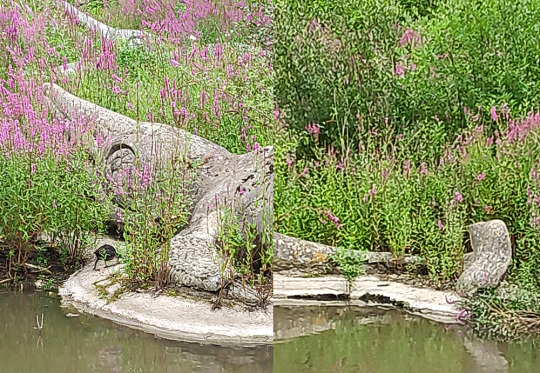
Head, flipper, and tail details of the Temnodontosaurus. A second ichthyosaur is just barely visible in the background.
Ichthyosaurs were already known from some very complete and well-preserved fossils in the 1850s, so a lot of the anatomy here still holds up fairly well even 170 years later. They even have an attempt at a tail fin despite no impressions of such a structure having been discovered yet! Some details are still noticeably wrong compared to modern knowledge, though, such as the unusual amount of shrinkwrapping on the sclerotic rings of the eyes and the bones of the flippers.

———

Arranged around the ichthyosaur, three different Jurassic plesiosaurs are also represented – “Plesiosaurus” macrocephalus with the especially sinuous neck on the left, Plesiosaurus dolichodeirus in the middle, and Thalassiodracon hawkinsi on the right.
They're all depicted here as amphibious and rather seal-like, hauling out onto the shore in the same manner as the ichthyosaurs. While good efforts for the time, we now know these animals were actually fully aquatic, that they had a lot more soft tissue bulking out their bodies, and that their necks were much less flexible.

———
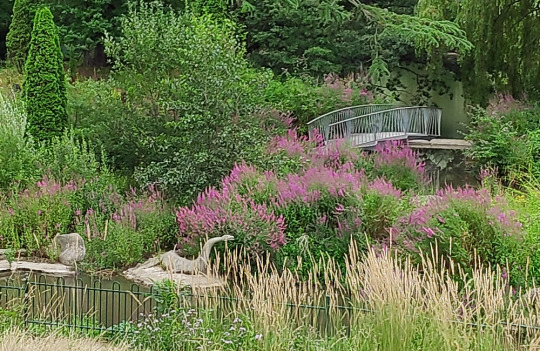
The recently-installed new pivot bridge is also visible here behind some of the marine reptiles.
———

Positioned to the left of the other marine reptiles, this partly-obscured pair of croc-like animals are teleosaurs (Teleosaurus cadomensis), a group of Jurassic semi-aquatic marine crocodylomorphs.

A better view of the two teleosaurs by MrsEllacott (CC BY-SA 4.0)
The Crystal Palace statues have the general proportions right, with long thin gharial-like snouts and fairly small limbs. But some things like the shape of the back of the head and the pattern of armored scutes are wrong, which is odd considering that those details were already well-known in the 1850s.

———
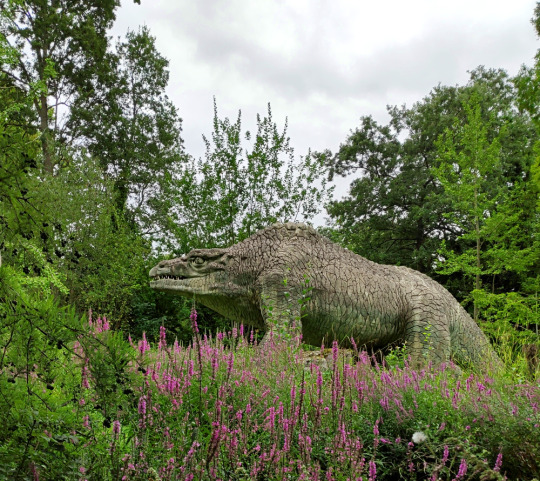
Finally we reach the first actual dinosaur, and one of the most iconic statues in the park: the Jurassic Megalosaurus!
Megalosaurus bucklandi was the very first non-avian dinosaur known to science, discovered in the 1820s almost twenty years before the term "dinosaur" was even coined.
At a time when only fragments of the full skeleton were known, and before any evidence of bipedalism had been found, the Crystal Palace rendition of Megalosaurus is a bulky quadrupedal reptile with a humped back and upright bear-like limbs. It's a surprisingly progressive interpretation for the period, giving the impression of an active mammal-like predator.
This statue suffered extensive damage to its snout in 2020, which was repaired a year later with a fiberglass "prosthesis".

———
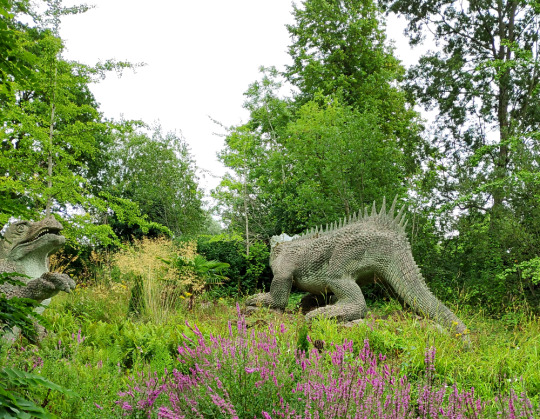
Reaching the Cretaceous period now, we find Hylaeosaurus (and one of the upcoming Iguanodon peeking in from the side).
Hylaeosaurus armatus was the first known ankylosaur, although much like the other dinosaurs here its life appearance was very poorly understood in the early days of paleontology. Considering how weird ankylosaurs would later turn out to be, the Crystal Palace depiction is a pretty good guess, showing a large heavy iguana-like quadruped with hoof-like claws and armored spiky scaly skin.
It's positioned facing away from viewers, so its face isn't very visible – but due to the head needing to be replaced with a fiberglass replica some years ago, the original can now be seen (and touched!) up close near the start of the trail.


———

Two pterosaurs (or "pterodactyles" according to the park signs) were also supposed to be just beyond the Hylaeosaurus, but plant growth had completely blocked any view of them.
Although these two statues are supposed to represent a Cretaceous species now known as Cimoliopterus cuvieri, they were probably actually modeled based on the much better known Jurassic-aged Pterodactylus antiquus.
A second set of pterosaur sculptures once stood near the teleosaurs, also based on Pterodactylus but supposed to represent a Jurassic species now known as Dolicorhamphus bucklandii. These statues went missing in the 1930s, and were eventually replaced with new fiberglass replicas in the early 2000s… only to be destroyed by vandalism just a few years later.
(The surviving pair near the Hylaeosaurus are apparently in a bit of disrepair these days, too, with the right one currently missing most of its jaws.)

Image by Ben Sutherland (CC BY 2.0)
The Crystal Palace pterosaurs weren't especially accurate even for the time, with heads much too small, swan-like necks, and bird-like wings that don't attach the membranes to the hindlimbs. Hair-like fuzz had been observed in pterosaur fossils in the 1830s, but these depictions are covered in large overlapping diamond-shaped scales due to Richard Owen's opinion that they should be scaly because they were reptiles.
But some details still hold up – the individual with folded wings is in a quadrupedal pose quite similar to modern interpretations, and the bird-like features give an overall impression of something more active and alert than the later barely-able-to-fly sluggish reptilian pterosaur depictions that would become common by the mid-20th century.

(Much like the statues themselves, the "modern" reconstruction above is based on Pterodactylus rather than Cimoliopterus)
———

The last actual dinosaurs on this dinosaur trail are the two Cretaceous Iguanodon sculptures. At the time of my visit they weren't easy to make out behind the overgrown trees, and only the back end of the standing individual was clearly visible.

Named only a year after Megalosaurus, Iguanodon was the second dinosaur ever discovered, and early reconstructions depicted it as a giant iguana-like lizard.
The Crystal Palace statues depict large bulky animals, one in an upright mammal-like stance and another reclining with one hand raised up. (This hand is usually resting on a cycad trunk, but that element appeared to be either missing or fallen over when I was there.)
Famously a New Year's dinner party was held in the body of the standing Iguanodon during its construction, although the accounts of how many people could actually fit inside it at once are probably slightly exaggerated.
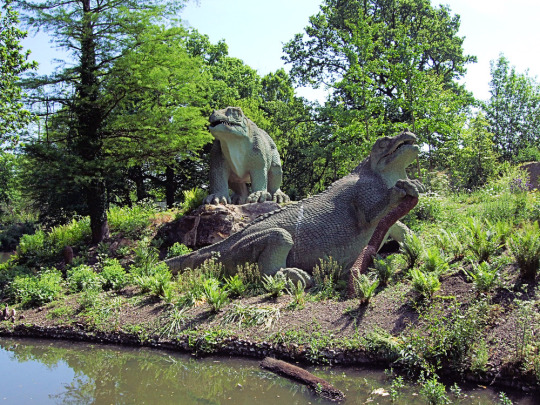
A clearer view by Jim Linwood (CC BY 2.0)
Considering that the skull of Iguanodon wasn't actually known at the time of these sculpture's creation, the head shape with a beak at the front of the jaws is actually an excellent guess. The only major issue was the nose horn, which was an understandable mistake when something as strange as a giant thumb spike had never been seen in any known animal before.

(The fossils the Crystal Palace statues are based on are actually now classified as Mantellisaurus atherfieldensis, but the "modern" reconstruction above depicts the chunkier Iguanodon bernissartensis.)
———
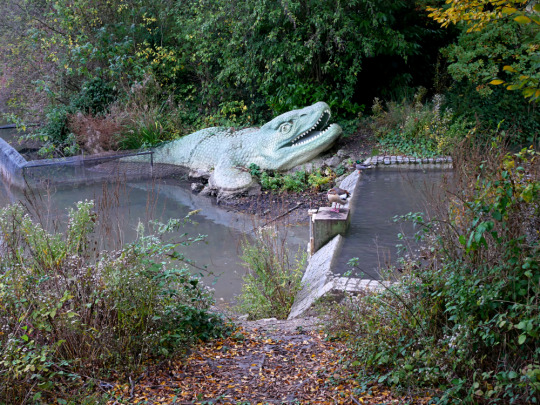
Image by Doyle of London (CC BY-SA 4.0)
I also wasn't able to spot the Cretaceous mosasaur on the other side of the island due to heavy foliage obscuring the view.
Depicting Mosasaurus hoffmannii, this model consists of only the front half of the animal lurking at the water's edge. It's unclear whether this partial reconstruction is due to uncertainty about the full appearance, or just a result of money and time running out during its creation.
The head is boxier than modern depictions, and the scales are too large, but the monitor-lizard like features and paddle-shaped flippers are still pretty close to our current understanding of these marine reptiles. It even apparently has the correct palatal teeth!

Next time: the final Cenozoic section!
#field trip!#crystal palace dinosaurs#retrosaurs#i love them your honor#crystal palace park#crystal palace#ichthyosaur#plesiosaur#teleosaurus#crocodylomorpha#marine reptile#megalosaurus#theropod#hylaeosaurus#ankylosaur#iguanodon#ornithopoda#ornithischia#dinosaur#pterodactyle#pterodactylus#pterosaur#mosasaurus#mosasaur#paleontology#vintage paleoart#art
467 notes
·
View notes
Note
Please tell me about the aliens. Please please please anything will do. Biology, language, temperments and personality, ANYTHING!!!!!!!!!!!!!!!
owo
Their home planet is largely wetlands, their feet evolved with opposable thumbs(? Are they still thumbs if it's on the foot?) For extra stability when standing on wet and slippery surfaces, like river rocks. Their natural stance is digigrade (weight solely on the toes), but shift to plantigrade when they feel unstable. Also their word for their planet roughly translates to water in the same way earth means dirt
While they do have lungs and don't generally breath through their skin like frogs, they can hold their breath for far longer than the average human. This is due to both increased lung capacity and minute amounts of gas exchange that happen through the skin. This is a vestigial trait from their amphibious ancestors that some members dont even have, and it does make them more sensitive to bad things in the air. They also prefer areas with higher humidity because of this.
There's very few if any mammals on their planet. On land its primarily reptiles and birds, but there's large numbers of aquatic species because so much of the planet is waterlogged.
Ok I've been trying for a WHILE to figure out what I could possibly use as a reference point for how their language sounds- I kept googling different reptiles/frogs but none of them were quite right but I JUST got it! They sound like the xenomorph! Clicking, hissing, that low growl. It's not one to one how I imagine them but it's a good starting point. When I describe them as chirping, I imagine it as similar to a chirping frog but in a lower pitch. The point is, their vocal chords are completely different than ours in a way that makes communication impossible- we can't replicate each other's sounds and a lot is lost in translation in both ways.
The boys have alien autism and are considered kind of weird. Sun is too much- too talkative too loud too expressive, while Moon is too little. He often doesn't emote unless he's angry so people can't get a good read on him. I'm still fleshing this part out but I them being socially awkward is important to me lol
Moon stims by gently pulling at his tendrils, while Sun is all about movement- he just needs to go go go!
I haven't quite decided if their relationship is platonic or romantic or a secret third thing, but they are life partners. This is another point where I have to figure out how I want their culture to work before I can really nail down specifics.
32 notes
·
View notes
Text
What native Gallifreyan species are there?
Gallifrey has a diverse range of fauna, both native and introduced. Despite claims of minimal ecological impact, the installation of the Eye of Harmony and millions of years of Time Lord civilisation have significantly altered Gallifrey's original biosphere.
🦋 Invertebrates
Beatitude Flies: Begin as maggots and pupate into golden-winged nocturnal insects. They use nectar to create helium in their bellies and are attracted to light and decay.
Butterflies: Various species flutter across Gallifrey.
Bees: Essential for pollination.
Gullet Grubs: Likely to live in digestive tracts of larger mammals, or similar environments.
Blossom Thieves: Possibly insects that steal nectar or pollen.
Scrubblers: Likely small, cleaning insects.
Neversuch Beetles, Sandbeetles, Waspbeetles: Various beetles.
Dustworms: Likely live in dry, dusty environments.
Scissors Bugs: Possibly predatory insects with sharp mandibles.
Flutterwings: Gigantic insects (3 meters by 25 meters) that never land. Five races include Wild Endeavor, Mandrigal, Silver-Band, Blue Crystal, and Perdition.
Snails
Water-Sligs: Likely aquatic or semi-aquatic molluscs.
Web-Spinning Insects: Including spiders about an inch long.
Other dangerous invertebrates: There are also nasty creatures that live beneath big stones.
🐟 Marine Life
Singing Yaddlefish: Notable for their song, and they can be eaten.
Kittensharks: Hatch from eggs and presumably grow into Catsharks.
Axolotl Salamanders: Amphibious creatures with regenerative abilities.
🐍 Elapids
Taipan: A venomous snake, 10 metres long.
Venal Snakes: Possibly nest-stealers or highly venomous.
Bat-Snakes: Presumably flying snakes.
Dinosauria: 20-meter-long reptiles resembling brontosaurs with thick chitinous scales and serrated teeth.
🦅 Avians
Owls: Symbol of Rassilon.
Flurry Birds: Likely small, fast-moving birds.
Trunkikes: Game birds whose eggs are often eaten.
Air Diamonds: Fly in the upper atmosphere, possibly crystalline or bioluminescent.
Song Birds: Various species.
Gargantosaurs: Dinosaur-like creatures, twice the size of a hab-bloc, with two legs, vestigial wings (with purple and white feathers), and four eyes.
🦣 Mammals
Plungbolls: Thumbnail-sized furry creatures living in mountains, attach en masse to warm objects.
Taffelshrews: Edible rodent-like mammals.
Fledershrews: Bat-like, mushroom eaters, nearly extinct.
Cobblemice: Mice that sprout wings.
Rovie Mice: Field-dwelling, long-lived if kept safe, sometimes pets. They have short memories.
Moss-Rats: Possibly rodents that live in marshes with moss-like camouflage.
Vex: Burrowing animals.
Gallifreyan Womprats: 1-metre-long rats with fifteen legs.
Pig-Rats: Inhabit the Drylands, presumably combining porcine and rodent traits.
Rabbits
Flubbles: Small six-legged koalas.
Unnamed rounder rabbit-like creatures
Ounce-Apes: Might be tiny monkeys that are particularly agile.
Sealak: Perhaps a kind of seal, often eaten.
Bear-Ass: A donkey-like animal with bear-like qualities.
Horse-Cats: Probably a horse/cat hybrid-like species.
Sagittary: Horse-like creatures.
Elephants
Pig-Bears: Can be trained as pets.
Wolf-like Creatures: With long snouts and black-and-white striped fur, almost as big as adult humanoids.
Broakir: Live in foothills, often hunted for food.
Baanjxx: Arboreal browsers that like to eat hallucinogenic cerub nuts. As a child, the Doctor was kicked by one in the head, apparently.
Cows
Walrus
Gallifreyan Marlot: Purple and unique in all of time and space. Probably a bit cat-like.
House Cats: Revered as symbols of intelligence. Traditionally, Presidents kept them as pets.
🐱 Killer Cats (C.A.T.S)
Killer C.A.T.S: These sapient creatures possess instinctive precognitive powers and cat-like physiology. Known for their lethal gladiatorial contests, they despise Time Lord traditions and live in the Gin-Seng Sector of Southern Gallifrey. Their culture includes mercenaries and oracles; they are telepathic.
🏞️ Ecosystem Preservation
Though Gallifrey's outer ecology has suffered, the Time Lords have used technology to preserve many species. Extinct species have been collected, ensuring none become completely extinct. The more fearsome creatures are contained in the Death Zone, while xeno-zoos hold alien species from other worlds.
🏫 So ...
So there's your whistlestop tour of the species on Gallifrey. One day, I'll try to put these onto a species distribution map. Oh, by Rassilon's Beard, I just gave myself more work.
Related:
💬|🪐🌍How is Gallifreyan geography different to Earth?: The landscape of Gallifrey.
📺|🌳🍎The Fruits of Gallifrey
💬|🐾🐱What could be some biological traits of Gin-Seng cats?: Looking at who the Gin-Seng cats are, their biology, and their place on Gallifrey and in society.
Hope that helped! 😃
Any purple text is educated guesswork or theoretical. More content ... →📫Got a question? | 📚Complete list of Q+A and factoids →😆Jokes |🩻Biology |🗨️Language |🕰️Throwbacks |🤓Facts →🫀Gallifreyan Anatomy and Physiology Guide (pending) →⚕️Gallifreyan Emergency Medicine Guides →📝Source list (WIP) →📜Masterpost If you're finding your happy place in this part of the internet, feel free to buy a coffee to help keep our exhausted human conscious. She works full-time in medicine and is so very tired😴
#doctor who#gil#gallifrey institute for learning#dr who#dw eu#gallifrey#gallifreyans#whoniverse#ask answered#gallifreyan culture
60 notes
·
View notes
Text
giving gillion a tail: bug's thoughts on triton anatomy
yeah im writing a full thing about this okay let me autism lazerbeam in peace.
so the thing with triton anatomy is that one would assume theyre just human anatomy with some extra bits like gills n stuff. and tails, but we'll go into that in a moment. the problem with this is bone structure. not all fish have bones. sharks don't have bones. instead the support structure of their bodies is made of cartilage. which isnt too different, considering parts of human anatomy are made up of cartilage, but it poses some interesting questions. im no scientist, but i am autistic as hell. so im going to pose a couple of options that are fun to rotate.
the most common depiction of tailed tritons (which i myself have drawn) is some variety of fish or shark. this is aesthetically fun bc of the variety within fish and sharks, in terms of colour and shape, that allows you to get funky with it. anatomically speaking, this would probably be achieved via the tailbone being there, like a monkey, but with the muscle and flesh around it being shark or fish-like. this would all lend to a tail that moves side to side, which would lead to an interesting swimming style that probably wouldnt involve much movement of the legs.
the second thought i had for tailed tritons was seals. seals have very short tails, but as mammals they have the same bone structure as humans. due to this, my initial thought was a second set of hips, so the triton bone structure would look like it had four legs, but the second set of legs would be the tail formation. this would lend itself to a tail that moves up and down, which could probably be utilised in tandem with the legs to create a very efficient swimming style.
however, neither of these ideas take into account one very important thing about tritons:
they're amphibious.
oh but bug, they can have human lungs and fish gills with nothing to do with the tail- silence voice i made up purely to disagree! we are not here to do arts and crafts! we are not gluing random creature aspects together with whimsy and magic! this is real science!
so amphibians. frogs and newts and salamanders and the like.
the amphibian life cycle, in most cases, involves eggs being laid in water and larvae being adapted to an aquatic lifestyle. frogs, toads, and salamanders all hatch with external gills, and develops lungs to breathe air as they grow up. amphibians are very adaptable to their environment, and there are many possible variations among individual species purely caused by outside influence and the area they grow up in.
but what does this have to do with tritons and their tails?
tadpoles
unlike most amphibians, frog tadpoles dont look like the adults. frog tadpoles start out fully aquatic, with external gills. as they grow and develop, they get gill pouches to make their gills internal. they have cartilaginous skeletons (which later develop into bone), lateral line systems (found in fish, used to detect movement, vibration, and pressure under water), and large tails. their lungs develop early. their front legs develop first, and then their back legs soon after.
(oh what about axolotls- axolotls dont have lungs. they are functionally the same as salamander larvae but they never get past that developmental stage. theyre amphibians that arent amphibious.)
im running out of steam for this post but basically what im trying to say is that triton are froglets. this would also make sense for the fact that triton have webbed hands and feet. frogs do too so it would be implemented into the swimming style. bone structure is a whole nother things, especially since both 'mordenkainen presents: monsters of the multiverse' and 'volos guide to monsters' are cowards whos triton designs are just blue people. but working from 'mythic odysseys of theros' designs, who have at least a little bit of flare, i think it's safe to assume that their bones are a little funky. some fun mix of bone and cartilage to have those interesting shapes.
all that being said, i am a big supporter of doing whatever you want forever. i am also just a massive nerd and like to think way too hard about these things.
(shoutout to my dad for assistance with bouncing ideas around, and for being the one to suggest the tadpole thing.)
#dnd#d&d#d&d triton#jrwi#riptide#jrwi riptide#gillion tidestrider#gillion jrwi#jrwi gillion#i did not proofread this at all godbless
79 notes
·
View notes
Text
Analysis of some details in Polar Town
Specifically locations 1, 3 and 5 of the UTTU part of Rayashki event. There are not a lot of screenshots - if you need some, I can DM them. Thanks to @vingler-mirror for the screenshots of Civic Square descriptions and the final Spotlight Chronicle
1 - Rayashki Elementary
Big-Eared Monkey and Mr. Crocodile - a reference to Cheburashka and Gena the Crocodile in form of August’s nicknames. The song Vila often sings might be based on The Blue Wagon from the 70s cartoon.
The collage shows not a bayan accordion but another accordion type called “гармонь” (garmon’) in Russian


2 - Hotel
Honestly, I believe Windsong enthusiasts will analyse the texts better than I could have









3 - New Mine
We’re getting more lore about the critters based on Inuit mythology. Kikituks are said to be evolved from shamanic statues into amphibious creatures and preferring mammal meat over fish nowadays. Ijiraks are said to be former people trapped into the boundary between life and death for wandering too far into the wild. Qiqirns are described as malevolent canines that wander aimlessly for eternity (it can be connected to their role in shamanism).
Information about the background character because I've got attached to him: the Rayashki guest arrived here following an Irish merchant ship. He’s a miner from Greenland expedition team with a bushy red beard and bear belly. He has a crude front but is a symphony enthusiast and likes literature - the temporary library helped him to bond with his teammates over literature without feeling weird. Also he has a little daughter. Pushkin’s Ode to Liberty that he read is a historically interesting piece where the author supports a political activist exiled to Siberia (the ode gets Pushkin exiled too but to a more gentle place)
4 - Swimming Pool
The descriptions go in chronological order of mermaid history.
@sleeplesssmol have copied Rusalka Spotlight Chronicle in their post here!






5 - Port
Among the stage descriptions, there are two interesting objects described:
A preserved seabird, seemenly for the migrated critters.
Rayashki Cheese - is said to be made out of milk from northern tundra. The cheese’s wrap design is based on Friendship cheese made by KARAT. The peculiar detail about it is that the only KARAT factory is in Moscow

Rayashki seemly participates in barter with the ships.
Cultural Palace - is a common name for major club-houses




6 - Civic Square








The polar bear statue was made after one of the meetings and now is taken care of as a symbol of the community
52 notes
·
View notes
Text
UDLTTOM DIALOGUE DRAFT #73
*Harry & Ted playing 2 truths and a lie with Tom & Knights of Walpurgis*
Harry: It’s my turn again? Ok Umm…I didn’t learn how to swim until I was eleven, I’ve never been to South America, and I’m an unregistered animagus.
Ignotus Avery (frustrated): Bloody hell! Why are these so difficult?! I believe all of these!
Harry: How are they difficult?
Alyxander Mulciber: After hearing you out raced a dragon on a broomstick anything goes at this point.
Lyra Burke: Oh, I do believe you are an animagus! That would make so much sense, wouldn’t it? How else are you able to slip away so often without being noticed? What’s your form?
Abraxas Malfoy: That’s not part of the game, Lyra.
Lyra: New game! Let’s try and guess Evans’ animagus form, every wrong guess you have to drink but if we get it right Evans has to down the rest of the bottle! And we get to ask you questions!
Harry: Alright, sure.
Lyra: Is it aquatic, amphibious, reptilian, or mammal?
Harry: None of the above. Drink.
Druella Roiser: Avian?
Harry: No, though it can fly. Drink.
Thaddeus Nott: Is it an insect?
*Harry nods*
Theodore (stunned disbelief): It’s a bloody cockroach, isn’t it?
*Harry passes bottle to Theodore*
Harry: Drink up, Ted.
-3 bottles & a half of Fire whiskey later-
Abraxas: -hic-I’m telling’ ya, he’s gotta be a blue morpho-hic- I’m a thousand present positive of it-hic
Walburga Black: Shhh, please! I insist that he’s lying. He’s a liar, Abraxas, he’s been lying about the whole thing tryin’ ta get us-hic-smashed. He’s got it written on his hand 🤚
Lyra: I think-hic- if I was a animagus I’d like to be a butterfly 🦋. It-hic-reminds of the Taoist philosopher Zhuangzi—
Harry (still mostly sober): Are you not going to guess, Riddle?
Tom: Oh, I wouldn’t dare presume.
Harry: That’s no fun. C’mon, don’t be a chicken.
Tom (unable to ignore the challenge): Fine, Evans. Let me think about it… An insect that can fly, it’s blue, is found commonly in gardens, but is not native to the British isles. Is it bigger or smaller than a knut?
Harry: Smaller.
Tom: And what country is it native to?
Harry: Australia.
Tom: What does it eat?
Harry: Mostly aphids.
Tom: Then it’s a pest controller…
Harry: Give up?
Tom: Do you? If I get it right you’ll have to down half a bottle of Fire whiskey in one go, Evans.
Harry: I don’t think you’ll get it right. You’d never guess it.
Tom: How about a wager, Evans, between just you and I? I get it wrong and I’ll write one of your essays for you, any subject, any length…
Harry: I’m listening.
Tom: But if I get it right, I get a kiss. Right here (taps lips)
Harry (laughing): You know what, fine. Sure Riddle. If you think you can guess it without asking another question.
*Tom whispers his answer in Harry’s ear & its right.*
Harry:
Oh shit!
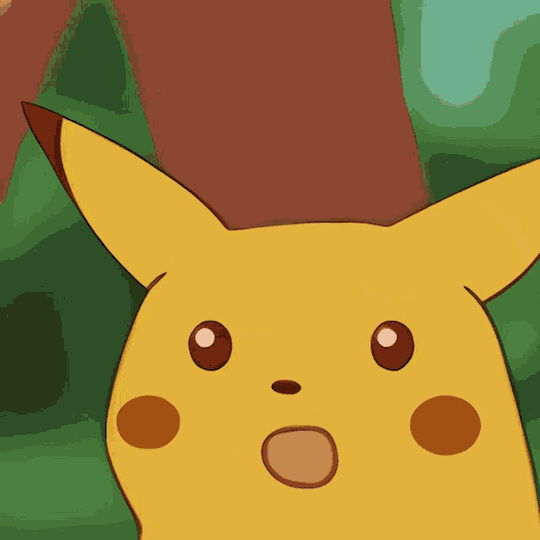
#udlttom#tomarry#time travel au#harry potter#tom riddle#tomarry fanfic#knights of walpurgis#2 truths and a lie#animagus#abraxas malfoy#ignotus avery#lyra burke#alyxander mulciber#walburga black#theodore nott#thaddeus nott#Harry makes an impulsive wager & immediately regrets it
174 notes
·
View notes
Note
are there some pokemon out there that would give birth to live young? or is it mostly by egg? and do mews and mewtwos give birth to live young?
To be honest, I know I'm probably not the only one to think this but this also might be an unpopular opinion, idk. I never cared for the idea that ALL the pokemon lay eggs, mostly when it comes to the mammal based pokemon. Now sure, it's a fantasy world full of monsters that can fit inside balls you carry around in your pocket, them laying eggs isn't the weirdest thing. But I'm an animal nerd. It's hard for my brain to wrap around that a dog/cat/rodent/equine/etc. based pokemon can lay eggs. My animal biology, scientific brain comes in like, an Arcanine should have a live litter of pups...a Persian should have a litter of kittens...In my universe they don't all lay eggs, just the ones that make sense for them to, like the reptile/dragon, amphibious, bird, fish, bug like pokemon.
So yes, the mews and mewtwos have live offspring
82 notes
·
View notes
Text

This drawing of the Lake Tanganyika Monster was created by Philippe Coudray for his book, Guide des Animaux Cachés. This creature is said to reside in Lake Tanganyika in Burundi, a country in East Africa. The lake monster was supposedly first described in 1893. Joseph Augustus Moloney claimed that a Mpala missionary described a 30 foot long sea serpent in the waters. He later claimed to see the beast on the shore, sleeping. In 1907, a sighting by a South African police officer claimed that the creature had tusks or fangs and that it was amphibious. This helped support the original claim of the creature being seen in the water and on land.
German doctor M. V. Thierfelder claimed to have seen the beast in 1914, while he was working in the area during an epidemic. He said that the creature was at least 50 meters in length. He wrote:
"Suddenly, I saw coming from the lake, in the bay itself, something that I had never seen. It was a creature that looked like a monstrous serpent. However, it did not swim like snakes in horizontal movements, but its rings—I counted as many as six—rose vertically above the water. The animal arrived in the bay at a fairly brisk pace, and went straight to the vicinity of the rocky shore, on which I was lying motionless. [...]
The beast had neither legs, nor stumps, nor fins. Near the head, however, there were slender fin-like structures on either side. The colour of the animal was a bright brown; it had no scales, but was covered with a thick fleece. [...]
The head was difficult to make out because it only appeared fleetingly above the water, but it was not wider than the body and was not separated from it by a constriction. It was not like a serpent's head, but, rather, that of a mammal, a manatee for example. The mouth, however, appeared narrow and elongated.
After the giant beast had spent some time moving among the otters, it turned around and came out of the bay in majestic undulations."
32 notes
·
View notes
Text

Between 100-130 million years ago on Atterra, lophiiformes (anglerfish) split off from other teleost fish and began diversifying much like their Earth counterparts. During this period, a group of early anglerfish began to crawl along the ocean floor, just like the extant frogfish of Earth. This lineage of anglers found their way into the hollows through flooded or underwater tunnels. Slowly transitioning from salt water to brackish waters before finally becoming freshwater fish as they adapted to their new environment. These underground anglers began to use their diminishing swim bladder as a basic lung as they clumsily walked across the cavern’s floor in search of new hunting grounds and/or water sources to breed. Each new generation of these amphibious anglers became increasingly efficient at terrestrial locomotion. As time passed, the rays of the amphibious angler’s fins fused to resemble tetrapod limbs. This adaptation allowed them greater survivability from predation by anthropods (arthropods that diverged early in their evolution, developing an internal skeleton, lungs, and a closed circulatory system). Enabling them to diversify into different niches.
As their limbs became more specialized for movement on land, the terrestrial anglerfish split into three distinct lineages found in the second and third layers of the hollows. The more basal ambush predators who continued to live a more amphibious and sedentary life stayed close to water, utilizing camouflage and their lures to hunt prey in competition with small amphibians inhabiting the hollows. Most species specialized in running down prey lost their lure entirely, filling small to medium grazers and predators niches. Those specializing in climbing and arboreal life developed long, prehensile tails to help them navigate their environment. A handful of these species have colonized Atterra’s surface to varying degrees. Due to terrestrial anglerfish having four legs instead of three like the terrestrial mudskippers, terrestrial anglers can reach larger sizes on average than terrestrial mudskippers. With the average height of many terrestrial anglerfish species being waist to chest height of most humans.
Anatomy/ Physiology:
Terrestrial anglerfish have four-chambered hearts like birds, mammals, and other terrestrial teleost fish. The hyoid bone and inner ear bones are formed from the gill arches of the terrestrial anglerfish; the gill arches ossifying and attaching to the back of the lower jaw to form the ear bones of the animal. Like terrestrial mudskippers, the terrestrial anglerfish has four nostrils, the two on the end of their snout, and the two under their back legs evolved from their gill openings, which were used in the same way as frogfish as a means of jet propulsion by gulping in water through the mouth and pushing it out through their gill openings.
Like in other terrestrial teleost fish, the gill covers form into an outer ear to help it detect sounds. Since anglerfish devour prey through suction feeding, terrestrial anglerfish adapted their jaws to hunt prey on land efficiently. An extra jawbone attached from the back of the bottom jaw and the temple (as seen in some anglerfish, such as monkfish) enables terrestrial anglerfish to extend their jaws forward in the same way sharks can. Once extended, the top jaw swings downwards to shut the jaw to grab its prey. The jaws are then retracted as the extra jawbone is pulled back into its resting position. To aid in prey capture, some terrestrial anglerfish also possess an extendable tongue like a frog or chameleon to secure prey and pull it into the animal's jaws.
Specializations:
Species that have lost their lure use their two remaining dorsal spines for display and as a signifier of their health to fellow competitors and possible mates. The aboral species of terrestrial anglers use their long prehensile tails to grip tree branches and fungal towers as a fifth limb. Some species even use their tails, like boa constrictors, to constrict their prey.
#fantasy#creature#creature art#creature design#monster design#monsters#speculative biology#speculative evolution#art#artwork#digital art#my art#illustration#drawing#digital illustration#sketch#skeleton art
11 notes
·
View notes
Text
So I’ve been thinking of Nautolans recently because of my ocs, and I just thought I would share a cute thought
I think that Nautolans, even though they have a very different kind of reproductive cycle, have a very interesting relationship with unborn mammal young, because they are ‘in the water’ for their development.
Trying to tell them that developing mammal foetuses aren’t water creatures doesn’t work. They’re like nope, till it’s born it’s one of us.
There is a Nautolan Healer in the Temple who specialised in interspecies obstetrics to treat the citizens who work in and around the Temple, and a lot of the Nauts in the Medicorps will say things like ‘you are carrying oceans inside of you rn’ or some shit. and in their eyes that is like carrying something life giving and very holy, you know?
And obviously mothers who are tired and fucking feel like they are carrying oceans inside of them are like ‘you don’t say’ (sarcastic) because fuck poetry, they would like the ocean outside of them now, please.
Also some Nautolans say that the mammals coming out of the waters and not going back in means they have a lot in common with those Nautolans who never quite get back to the water after aging out of the time when they are in tank because they havenMt properly developed arms and legs yet.
Low economic demographic nauts on Coruscant or other places with water scarcity have a very hard time necessary getting water time, and some have evolved over the course of generations on Coruscant to not need as much. They can survive with water showers and don’t need to sleep in their tanks.
btw other amphibious species don’t think the same thing, Bant Eerin hears the Healer guy talk and is like ‘What are you on man? amniotic fluid is not an ocean it’s completely different. We are scientists! We use technical terms for a reason!’
#nautolan#mon calamari#near human#mamalian species#star wars headcanons#now I need to think of a name for this coruscant nautolan healer#as opposed to my other nautolan healer#nafis ta#who I haven’t done a write up here for yet#pregnancy#tw tokophobia#star wars ocs#my ocs
11 notes
·
View notes